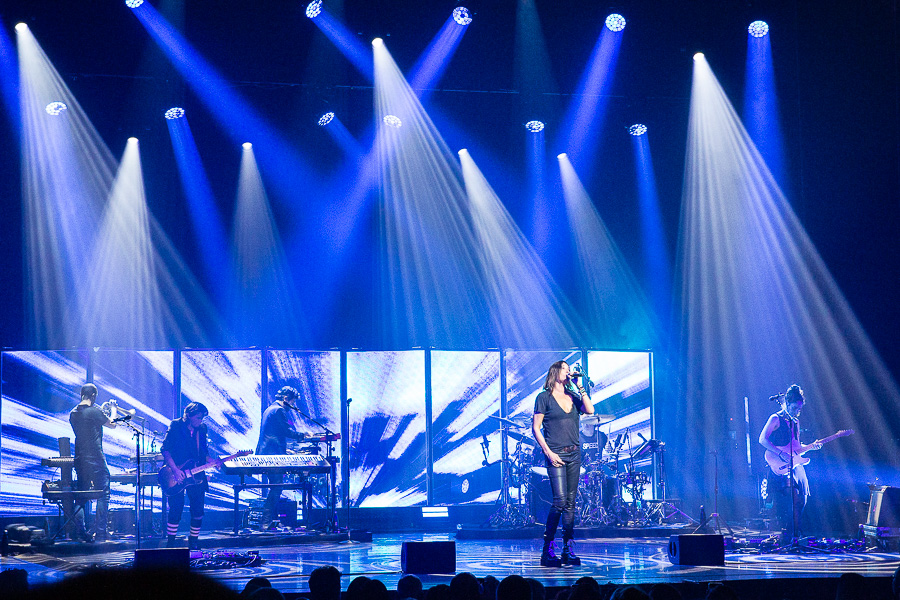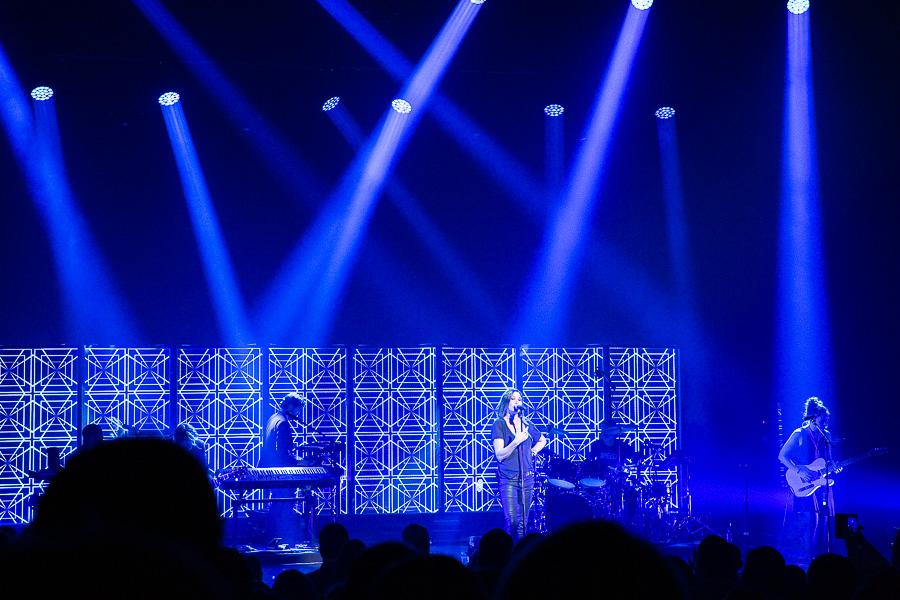
The multifaceted and emblematic Zazie is alternately a model, a singer, a TV talent show voice coach and, above all, the author and composer of well-known French pop music, deeply in love with the French language and with her audience.
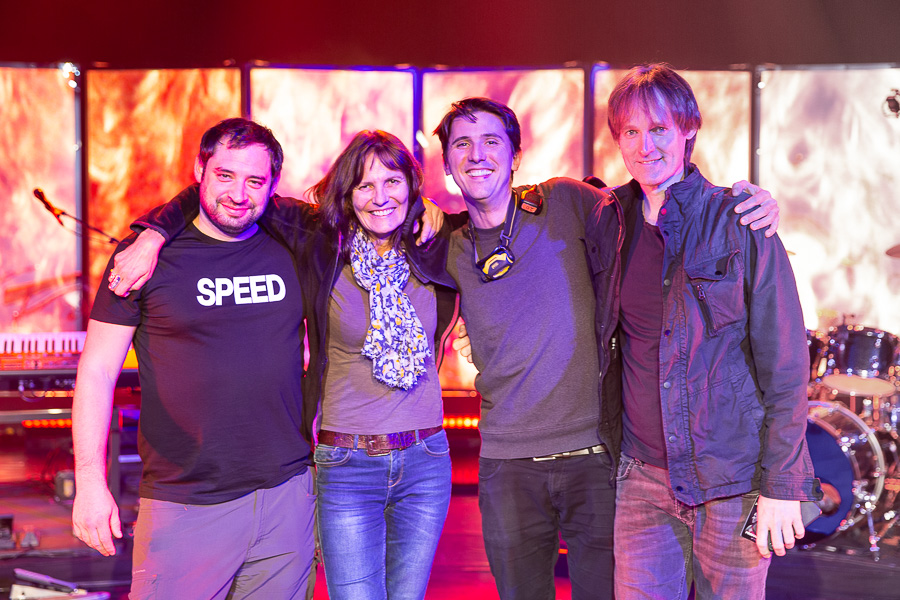
She needed a lighting team that could live up to her imagination, and she found it with that little bit of madness that makes all the difference in Andi Watson, her lighting designer, and Laurence Duhamel, her lighting director, as well as Harold and Sylvain. The four of them were ready to get the job done.
I take the train to Lille from Paris where I join the lighting team near the Théâtre Sébastopol, a 19th century establishment recognizable by its enormous stage cage visible from the outside. I meet them in a restaurant where they round off their lunch with a little coffee and a diabolo grenadine. Immediate boarding for planet Zazie!
Laurence, Harold and Sylvain make up the lighting and visual team for the tour – Laurence, along with Sylvain or Harold for the lighting, while Mika handles the video. Andi Watson, the lighting designer who created the show, joins them on a few dates to help evolve the programming.
A Completely LED Rig
Laurence is a lighting designer and console operator. With over than 30 years of experience in this field, she has, among others, worked for Sexion d’Assaut. In fact, we have written about her here. She’s a wonderful gal, with exceptional empathy, who suggested that I go for a tour of the decidedly modern and powerful LED rig of this tour, supplied by S Group.
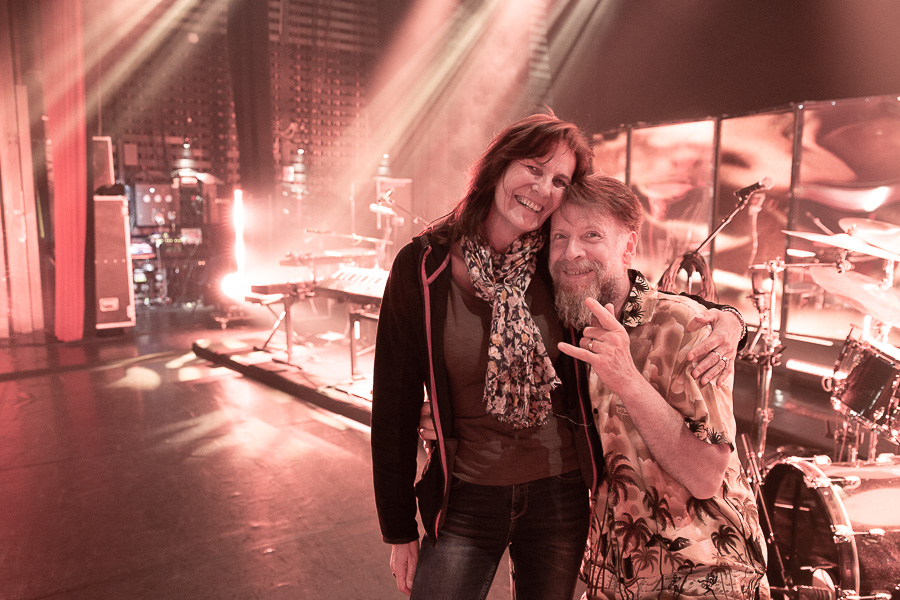
the transition is complete here, as one of Ayrton’s most recent creations, the Khamsin spot/profile, leads the way. The kit also includes Spiider, the latest multi-source LED wash from Robe, as well as the X4 Bar and JDC1 from GLP.
All of them are LED fixtures, which have their advantages and disadvantages compared to lamps. Even though these units are catching up in terms of power, they are perceived by some musicians as a bit aggressive to the eye.
SLU : Could you explain the rig in more detail? Shall we start with the Khamsins?
Laurence Duhamel : The Khamsins mounted in the grid are used in the conventional way: for beams and gobo projection, or for strobing.
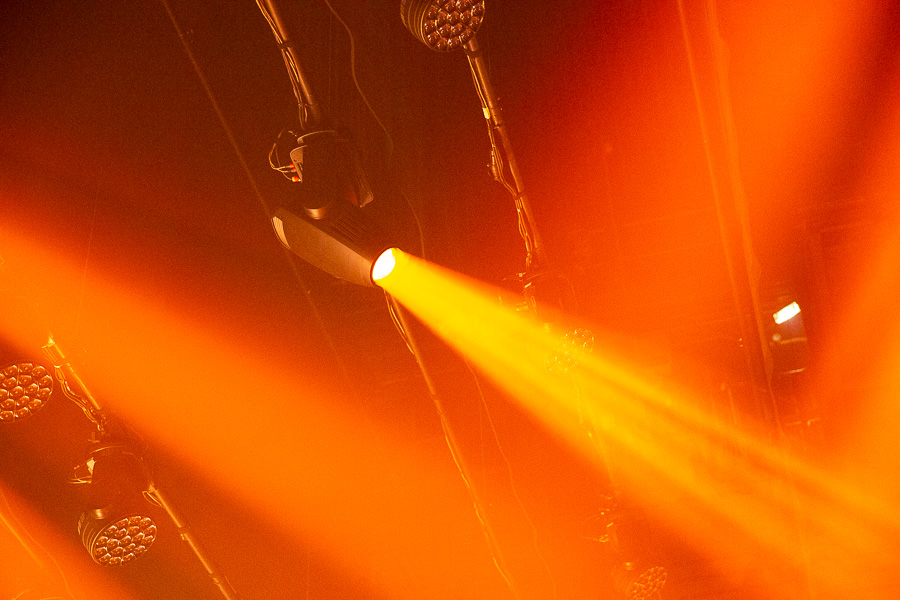
There’s everything in them. There are two rotating gobo wheels, which leaves quite a wide choice with six gobos per wheel plus the animation wheel, especially since the gobos are really interesting.
And then there are the framing shutters, the iris, the focus and the zoom. All things considered, it’s quite heavy, at 39.8 kg, but it’s very complete and offers a nice dimmer curve and a nice strobe curve too.
It’s a nicely built unit. I was pleasantly surprised by the white beam, which is very well calibrated. It doesn’t have a hot spot in the middle, like you get with other fixtures or Beams. The big advantage of this light is that its white LED source is powerful enough to push through the color wheel and have nice color mixing. It produces great bright colors, with greens and pastel hues. This eliminates the very “RGB” aspect of LEDs.
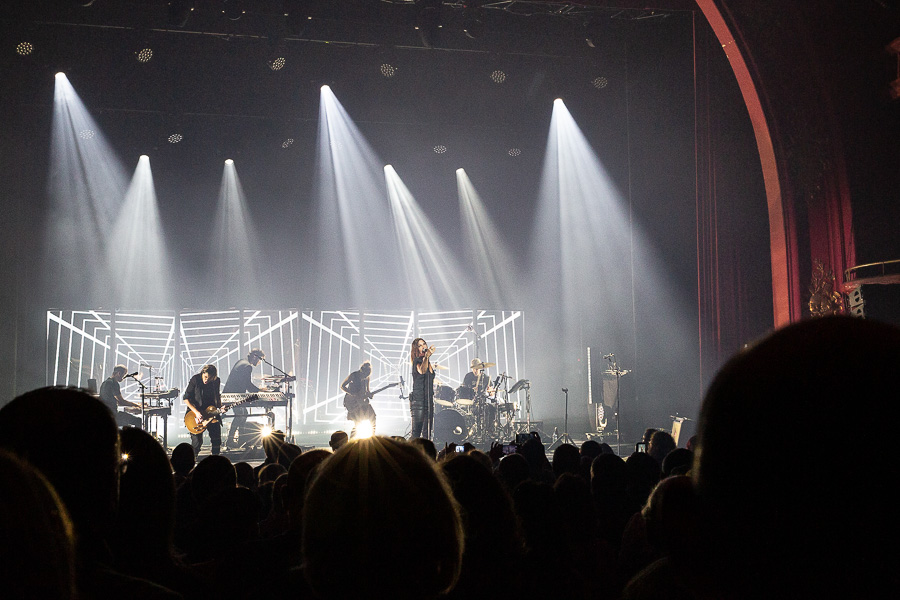
SLU : Was that a concern you had?
Laurence Duhamel : Yes, definitely! And whether it’s an Ayrton, a Robe or a GLP, they allow you to get real deep blues, and real UV… something we’ve never had before. The UV is the blue LED that we darken by lowering the intensity, without ever having it the way we’d like… It’s a filter that we use a lot in shows and when you don’t have it, well, you suffer… (laughs). Likewise, when you can’t create beautiful acidic greens, it’s a shame! And when you get an ideal green, it’s usually at the expense of amber.
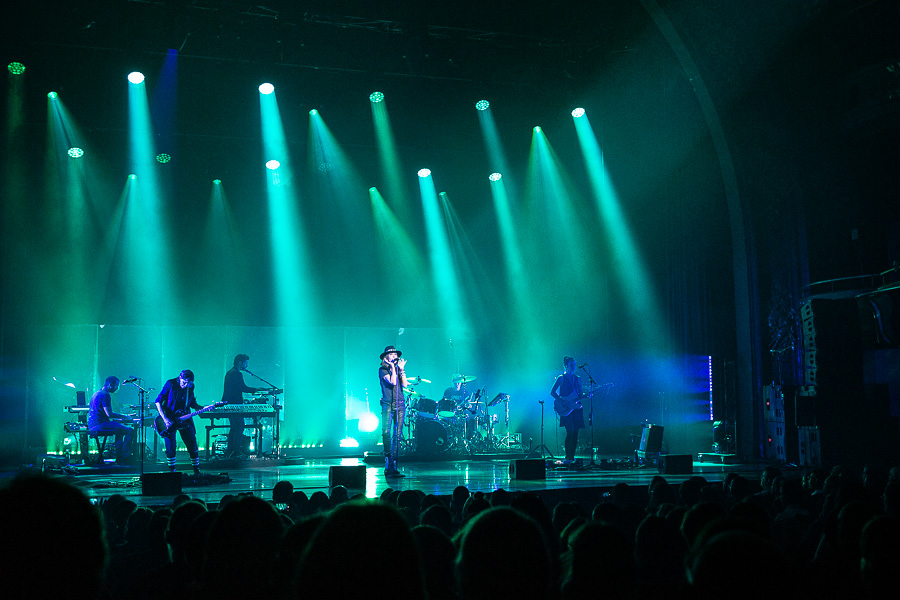
SLU : Do these LED fixtures save on costs?
Laurence Duhamel : They consume less power, even though it’s still 1,100 W for the Khamsin. As there is no serious heating, the mechanics suffer less and therefore the fixtures are more reliable. plus there is no lamp to replace.
On a rig like this, completely LED, we’re at less than 60 amps per phase, whereas we’d be at 120 amps per phase on a rig with conventional lamps. This means lower power consumption, less heating, fewer breakdowns… it’s easier to manage on the road.
SLU : Are there any issues related to these “new” light sources?
Laurence Duhamel : No, not really, except that the flicker frequency can be unpleasant for the eyes of sensitive people. Indeed, for performers on stage as well as for technicians, getting the light from a lateral source in the eyes can be uncomfortable. The monitor engineers position themselves so that they don’t have these LEDs in their eyes all night long.
Zazie doesn’t complain about it but there are artists who can’t stand it. The fixtures hung in the roof aren’t bothersome, nor are the front lights, because the singer and her musicians are mainly looking at the audience. It’s really what’s on the floor that’s hard for them to bear. But you have to light them, so there aren’t too many alternatives.
SLU : There are also 20 Spiiders in the rig…
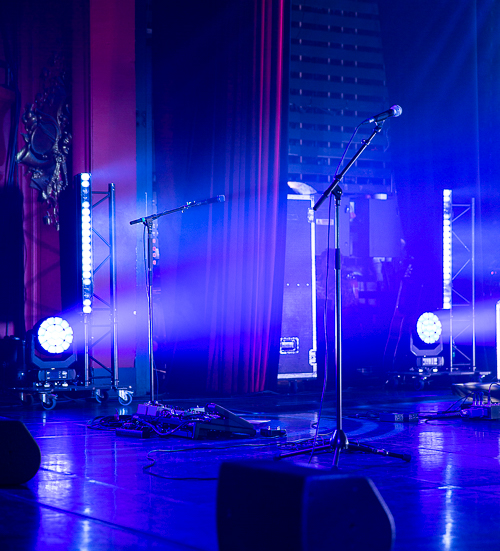
Laurence Duhamel : They are hanging from the back truss and the down-lighting truss. The Robe Robin 600 was one of the pioneer LED washes. The Spiider is even more powerful. It’s a great unit that puts out a lot of light.
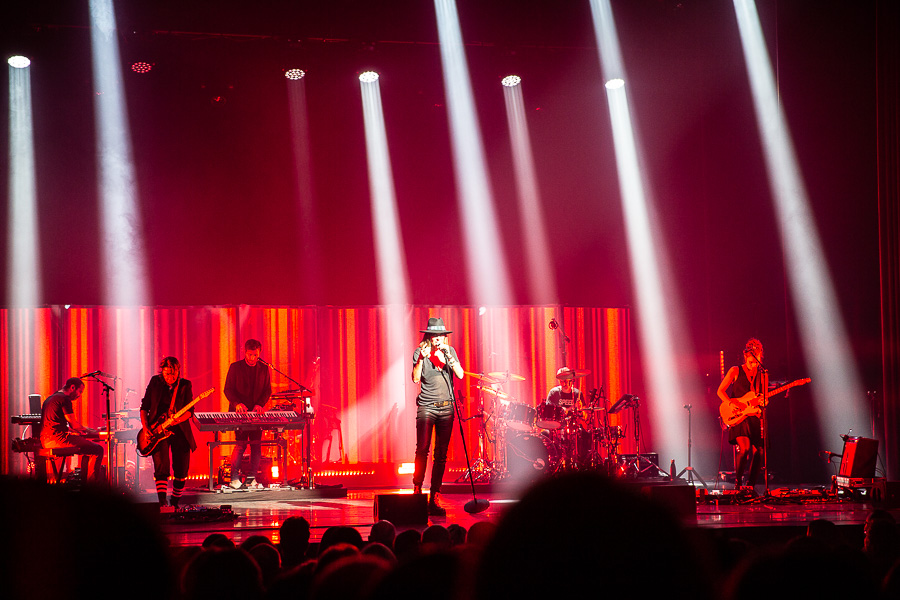
There is also one on each of the four lateral totems, two on the right and two on the left, that, together with an X4 Bars, provide lighting for the musicians. Finally, on the floor in front of the screens, there are alternating X4 Bar20s and JDC1s.
SLU : The combination of GLP X4 Bars and JDC1s made sense to Andi Watson, who designed the rig?
Laurence Duhamel : Yes, they have exactly the same colorimetry because it’s the same manufacturer. The X4 Bar 20 opens up enough to light the musicians laterally without having to move them too far away, which is the case here because the totems are 1.5 meters away from a musician, and we can cover them well. It’s a really good fixture with nice colors.

The JDC1 can be pixel mapped, with its 12 zones that can be independently controlled in intensity and color around its line of white LED strobes in the middle. The tilt of the fixture is also motorized. And it also produces very beautiful colors – real UV and real pastels – and that’s not always easy with LEDs, which always have a slightly acidic and electric aspect. But that’s really unique to GLP. I’m happy with it; it’s solid and it’s got punch!
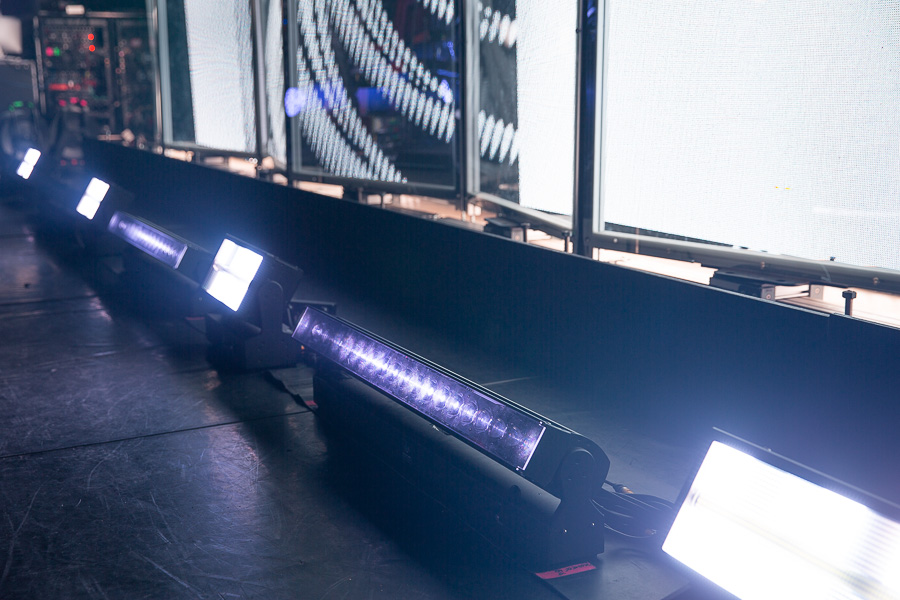
SLU : How do you use this line of back lights?
Laurence Duhamel : We mainly use them to punctuate the beat. We do some little chases on the X4 Bars that we repeat on the totems with the same effects.
SLU : Have you had any technical problems with these fixtures?
Laurence Duhamel : Only one mechanical problem: the gobo wheel of one of the Khamsins was rotating but jerky, and we had one broken dichroic glass because they can get a little roughed up during transport… so, it happens. As for the Spiiders, we had a failure on one of the central LEDs, due to a soldering problem.
SLU : How are these problems dealt with?
Laurence Duhamel : S Group takes care of them via Sylvain Ibanez (sometimes substituted by Harold Mathieu, as here in Lille). He is the one on the tour with us responsible for the lighting company. A malfunctioning fixture is automatically replaced. In the past, we would repair them on the road because there were a lot of breakdowns, but it’s no longer the case these days. For the broken filter, we only changed the tray, not the fixture.
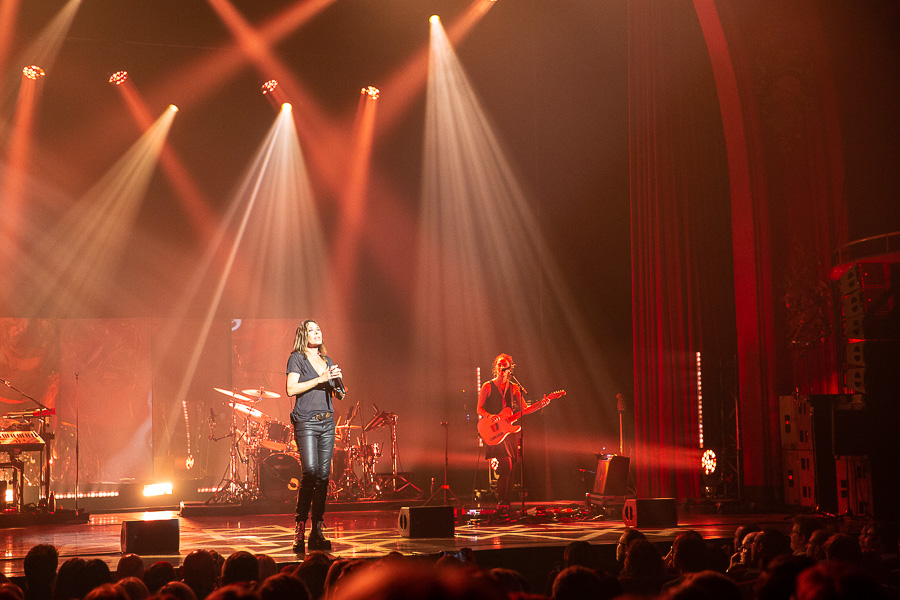
SLU : How is the network set up?
Laurence Duhamel : At the level of data transmission, there is Art-Net to control the video and lights, and MA-Net between the console and the NPU, because we work with the fixtures at full parameters. On a single DMX line, there are only five fixtures, that’s it (laughs). So inevitably we have a DMX line even with a small kit because the console is limited to 8 DMX universes.
As we’re well above that, we use an NPU to double that number. We run a fiber connection between two V-LAN switches. One V-LAN is for Art-Net and the other is for MA-NET. We could have configured a third V-LAN to run the intercom. On smaller projects like this, it’s not difficult to manage, but on larger projects, it’s a full-fledged switchboard, which is quite a new thing, by the way.
Made to order by Andi Watson
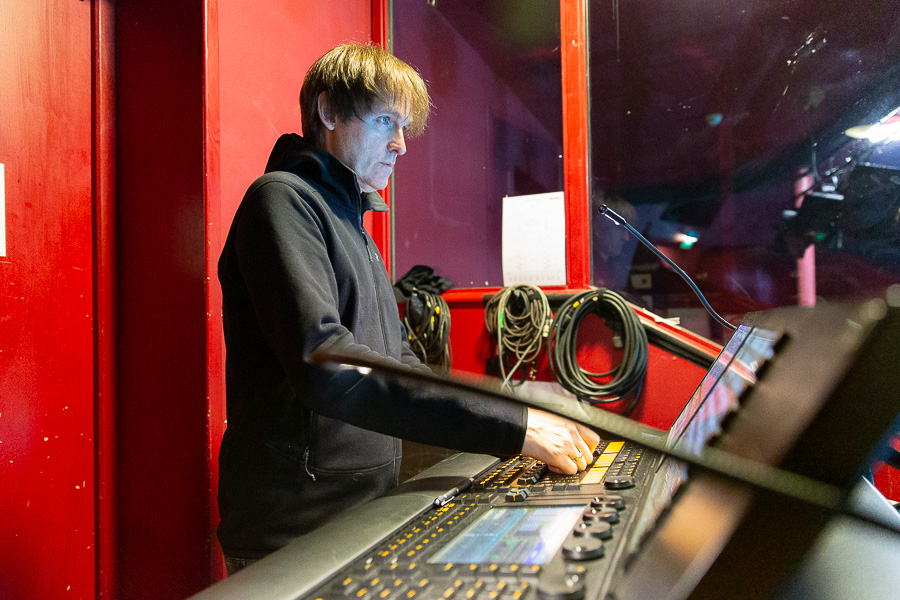
At the back of the stage, an LED screen displays the media from an image bank. Just in front of it, Andi chose to place some specially designed filter panels of the same height.
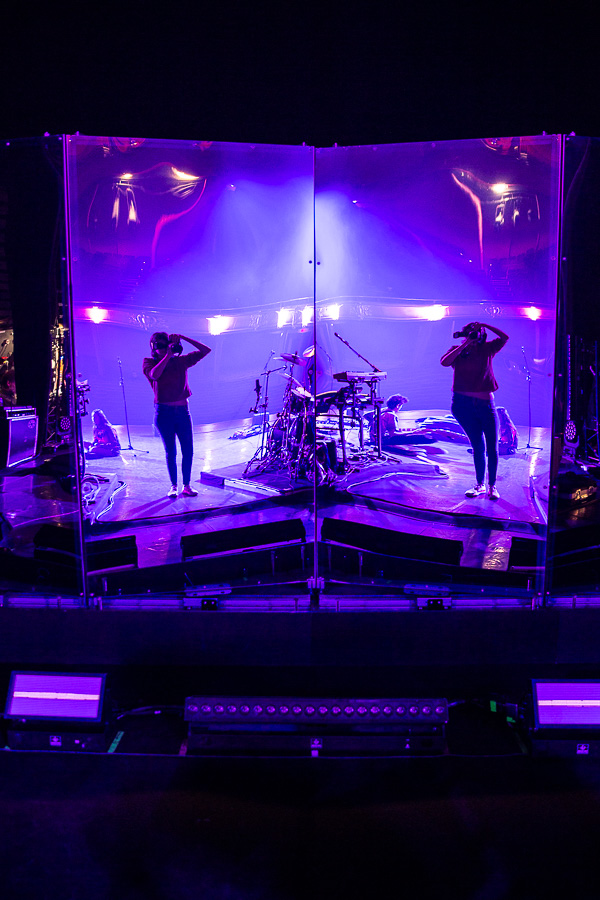
Only two manufacturers in the world supply them, one of which is located in the south of France. This material is durable, as the panels came through the 2019 festivals without breakage or scratches.
SLU : At the rear of the stage, you have installed a system of LED screens together with very unusual panels.
Laurence Duhamel : The material of these panels is quite flexible. With the changes in temperature, it evolves. In the morning, they’re all tight and warped, while in the afternoon they relax and soften in response to the heat, a bit like a mirror.
They can be arranged into cubes, or used in conjunction with video, as in this case. Our LED wall is positioned right behind these staggered panels. If we don’t light them from behind, they’re mirrors.
By lighting Zazie and the musicians, we have their reflections in the mirror, combined with the image displayed by the LED wall that passes through it. Zazie plays around with this for a bit during the show, which was the goal.
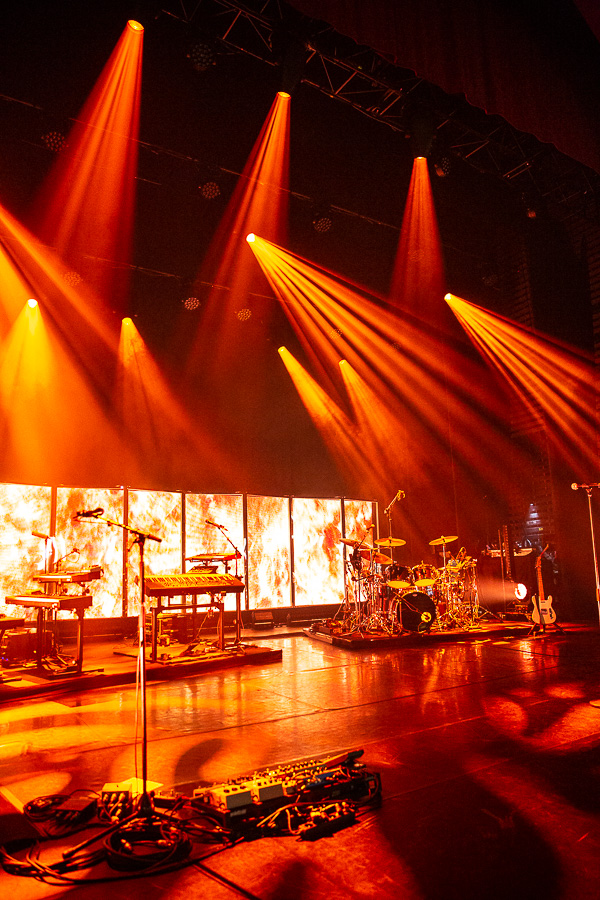
This concept, which Andi devised exclusively for this tour, was made to measure by S Group. You can change the angle of the mirrors, according to a configuration that has been carefully studied to adapt to the different sizes of the stages, which are sometimes small.
So here in Lille we have our eight panels, sometimes we can only fit six. So we give them a little more of an angle or we close them up some.
During transport, everything is optimized; the panels are protected with aluminum rails. Like the totems, we load them straight onto the truck. This saves space and time, too.
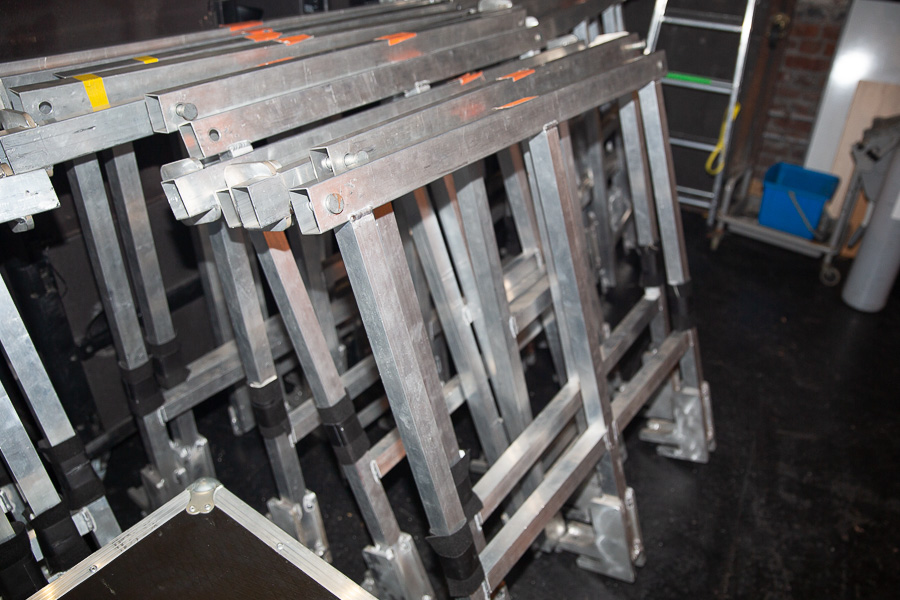
SLU : Did the LED wall require any particular adjustments to match the lighting fixtures?
Laurence Duhamel : We’ve lowered the intensity of the wall a little bit over its entire length. But, depending on the video content, which is more or less dense and dark, we vary the intensity from the console.
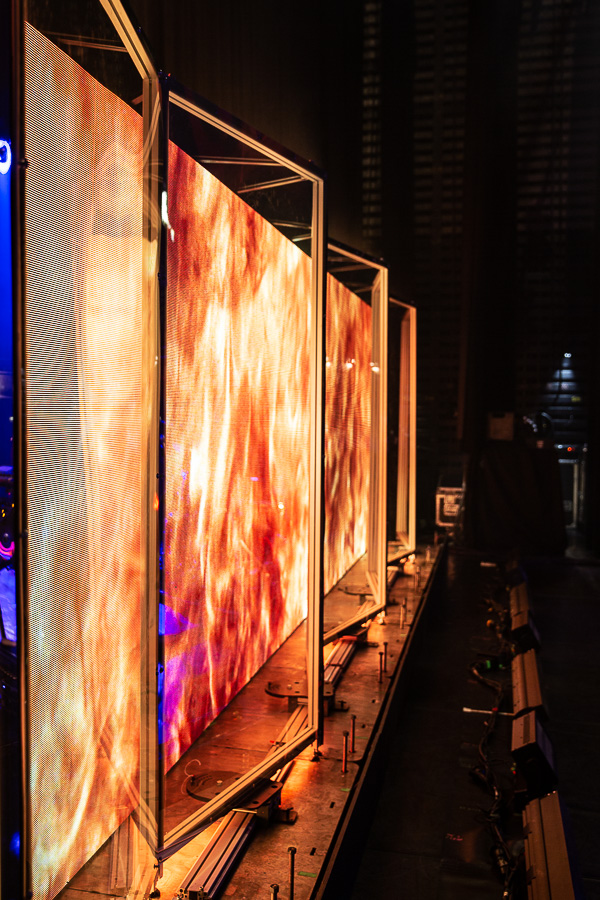
Obviously, the video wall installed at the back of the stage tends to reduce the depth a little. So, when programming, you have to strike a balance between the displayed content and the lighting. They are supplied with a classic 16 A power supply and the signal is daisy-chained from screen to screen.
SLU : How did Zazie feel about this set piece?
Laurence Duhamel : Zazie trusts Andi Watson, who has been her lighting designer for years. She approved this project from among several that he proposed to her. But I think she has always had some video, more or less of it depending on her budget. On the last tour, it was old TVs interwoven one on top of the other. On this tour, we’re playing more with the reflection of beams, the reflections within the scene…
SLU : Is there any time code on this show?
Laurence Duhamel : No, I’ve got everything on the grandMA. I feed the video content from the Catalyst, our server media. Everything goes through the network and I manage the image from the console, kind of like a supplementary fixture.
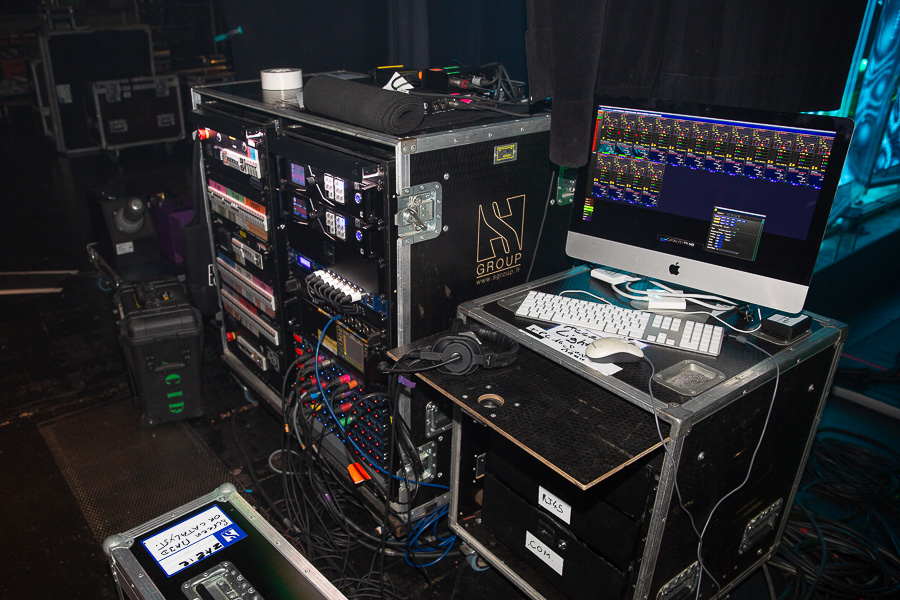
SLU : How long does it take to set up this rig?
Laurence Duhamel : It’s really quick. For the lighting, in 45 minutes we have rigged and tested everything that’s hanging. Then we wait for them to set up the stage to set up the video. In the morning, in three hours everything is set up: backline, sound, lighting and video.
SLU : For smaller venues are there any changes other than the size of the screen?
Laurence Duhamel : Our set is designed for a stage front width of 11 meters, which is the distance between the most widely spaced fixtures. It’s quite conventional because we based ourselves on a total width of 14 meters, which is about the same as the Olympia. Here in Lille we had to tighten it up a little bit. At the Vichy Opera, we couldn’t set up the video.
It wasn’t a question of a space on stage, but that we couldn’t get the LED panels into the building because the doors are too small. There were rooms where we had to limit the load by, for example, hanging only four Khamsins, or 160 kg + 20 kg of cabling. It’s in these moments that we found a different show.
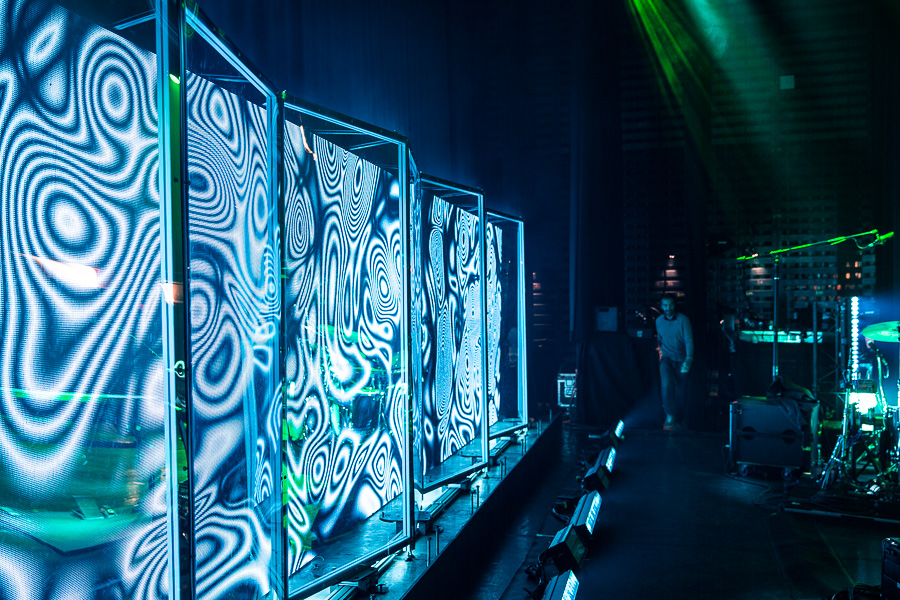
SLU : Could we talk about alternate versions of the show?
Laurence Duhamel : We always start from the previous day’s show, that is to say, with the latest modifications. But as far as the video is concerned, we have what we call mixes. There are several variations: a full mix with all eight panels and a mix with six panels.
On the other hand, the totems that are used to illuminate the musicians are essential. We played in a room where I couldn’t add any lighting on the floor, not even the totems. I had to use what was there. On the other hand, I was able to keep the back truss, which gives all the energy to the show.
RoboSpot holds the ‘key’
As Laurence has explained, she has to adapt her kit to the configuration of each of the venues on the tour. In Lille, she has to do without a front truss, which normally holds six Khamsins, four Spiiders and a BMFL/RoboSpot. Hence the importance of the side totems that light the musicians. This also explains the choice of the RoboSpot tracking system coupled with a BMFL to provide key lighting for Zazie, the only lamp-based fixture in the rig.

SLU : What do you think of the Robe “mopeds”?
Laurence Duhamel : I think they’re great! Being able to attach your followspot to the front truss and give it a bit of angle as needed is very handy, even if it’s not always easy to find a place for the BMFL with the remote camera in some theaters. When you’re in the Zenith and you have your front truss every day in the same place, it’s easy. But for us, every day it’s the same question: “So where are we gonna put it?”. And with the remote camera, there’s a little bit of latency. Harold or Sylvain, who control it through RoboSpot, have had a little time to adjust and now they have the hang of it. It’s like anything else.
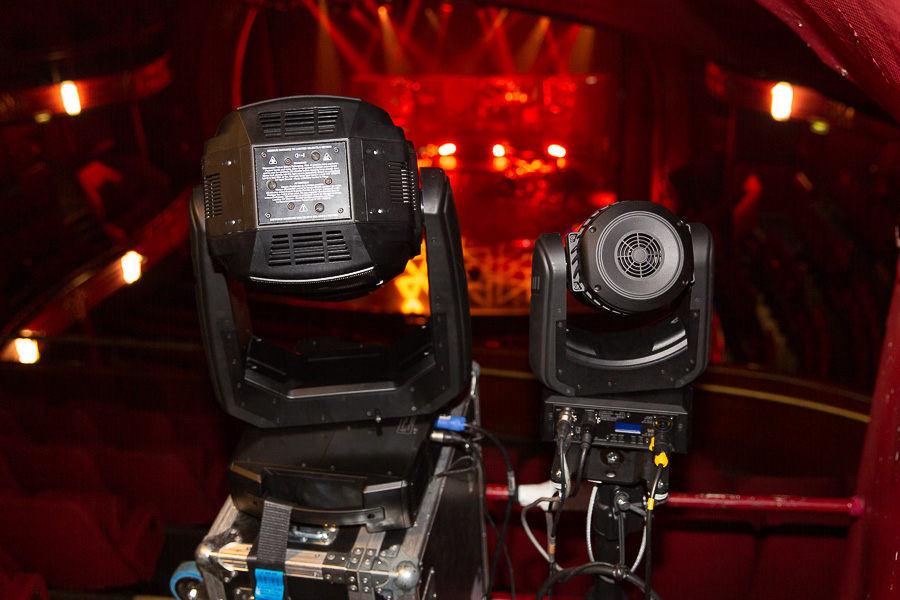
Anyway, I find it super-practical compared to a classic heavy and fat followspot that may require climbing a tower or being placed in the catwalks. And often you can’t get the right angle, whereas, with this system, you can do whatever you want with it. Still, we have to keep in mind that we are limited by the network cable and the maximum 80 meters between the operator position and the camera.
For this configuration at the Sebastopol theatre, we installed the ‘moped’ in the control room and the BMFL followspot in the upper balcony, for lack of other possibilities. As with other products, we have been looking for a solution and now we’re getting somewhere. On this tour, it’s used in its simplest expression, that is to say a followspot on a single artist, but on other tours where five, eight or ten fixtures are linked together, it’s magnificent.
SLU : What are the parameters controlled by the operator?
Laurence Duhamel : It has the classic pan, tilt, iris, zoom, focus and dimmer. As for me, from the console, I control the color, the dimmer and the effects.
Conclusion
This superb show is all nuanced by the work of the beams. Unfortunately, the still photos can’t capture Andi Watson’s meticulous programming, which contributes a lot of substance and detail to all the scenes. It’s alive; it’s beautiful. The Khamsins generate beautiful colors and sculpted beams with their elegant gobos. This is a choice tool for all lighting designers, and Andi Watson has embraced it.
The blue scenes are particularly effective, luminous and very intense plunging into some of the songs such as “Je suis un homme”, in which the artist bathes in the power of the Spiiders with a slightly electric Khamsin touch.
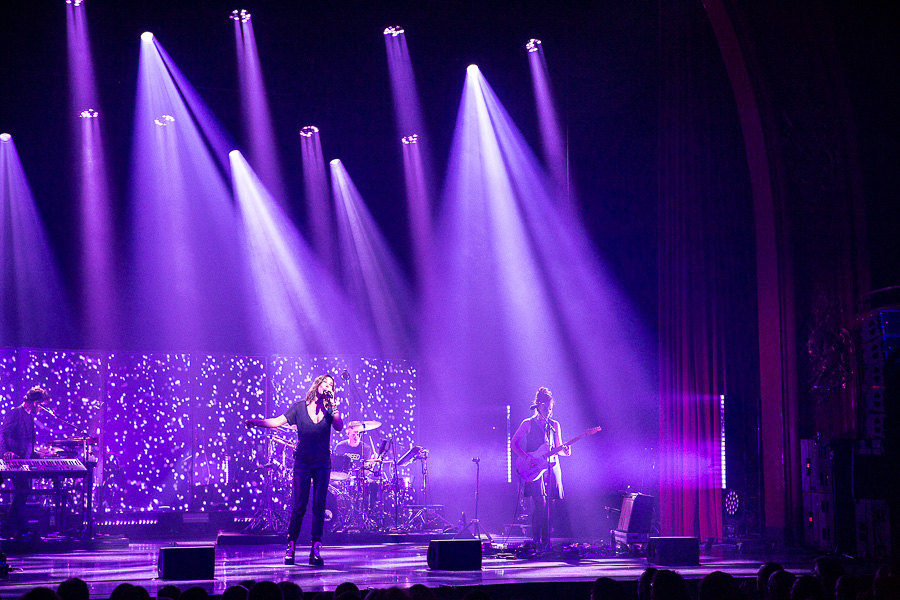
Electric and psychedelic, also, is the scene on “Toc Toc Toc” when the red beams of the Spiiders turn magenta in the powerful blue from the BMFL, all in front of the distorting effects of the panels. The atmosphere on stage is surreal.
The Khamsin’s beam is powerful in colors, and stands out from the Spiiders, even in blue tones. Andi also plays with the mirror effect to lengthen the beams. Between the content on the LED wall and the distorted reflections provided by this material (that comes alive according to the temperature of the room), the result is very vibrant, very elegant, and with a zest of madness.
The Video and Lighting team members
Andi Watson: Lighting designer
Laurence Duhamel: Lighting director/console operator
Sylvain Ibanez: S Group project head/RoboSpot operator
Harold Mathieu: RoboSpot operator
Michael Zeitoune : Video manager
Lighting equipment
– Ayrton : 13 Khamsin 750 W White LED 40,000 lumen (7 on the back truss and 6 on the front)
– Robe : 24 Spiider used in control mode 4 (12 on the back truss, 4 on the front, 4 for the audience, 4 laterally on totems) and BMFL Followspot
– GLP : 9 X4 BAR 20 15 WATT RGBW LED 4 laterally on totems for the musicians (5 on the floor upstage for backlighting, 4 JDC1 LED strobe + strobe-Tube LED et 12 12 pixel-mappable zones
– video equipment: 8 ROE LED panels 1.2 m x 2.40 m, 1 Catalyst media server



